If you haven’t tried making cultured butter then you are in for a treat! It’s fun and delicious. Perfect for making all sorts of different flavors of butter: garlic, herb, or lemon zest.
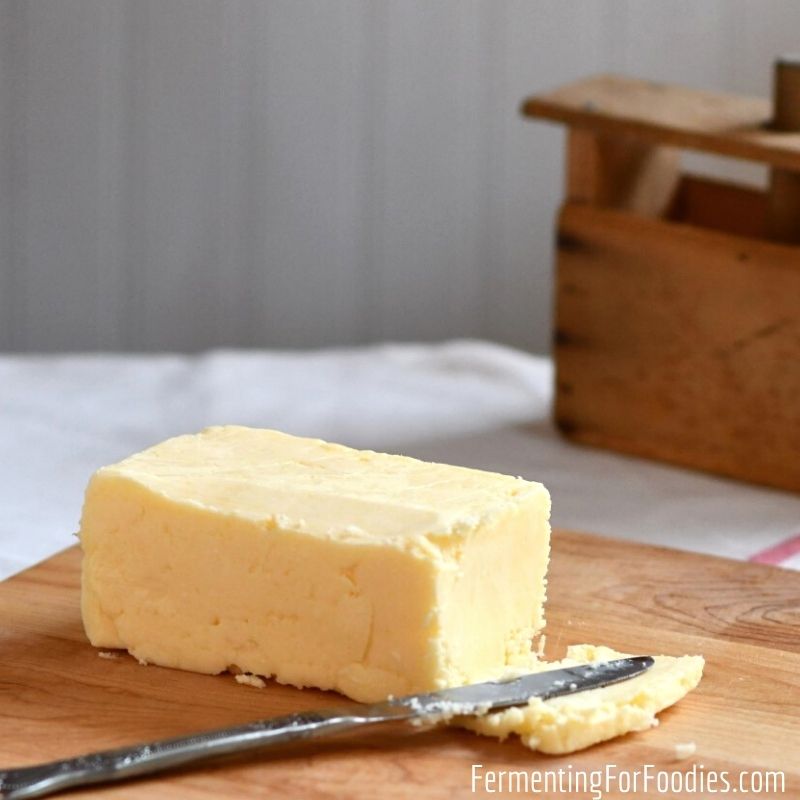
My husband is Doukhobor, which means that butter is a very important part of his diet. His mother gave us our milk kefir culture. And she regularly made batches of homemade cultured butter.
While we inherited her butter churn and butter press, they are basically museum pieces. We usually make butter in a mason jar! It’s really easy and fun. Perfect whenever you have a bit of extra whipping cream in the fridge.
Making butter in a mason jar
This cultured butter recipe was designed to be made in a large 1-quart mason jar. And the whole recipe can be made by shaking the jar of whipping cream. However, I usually kick-start the process using the whipping attachment on my stick blender.
When it’s fully whipped, then I put the lid on the jar and start to shake. At first, it feels like nothing is happening, but just keep shaking. It takes about 10 minutes of shaking to get the butter to separate.
This is a perfect activity for kids. It’s like a pass-the-parcel game. Everyone wants to be the one who is shaking when the butter finally separates.
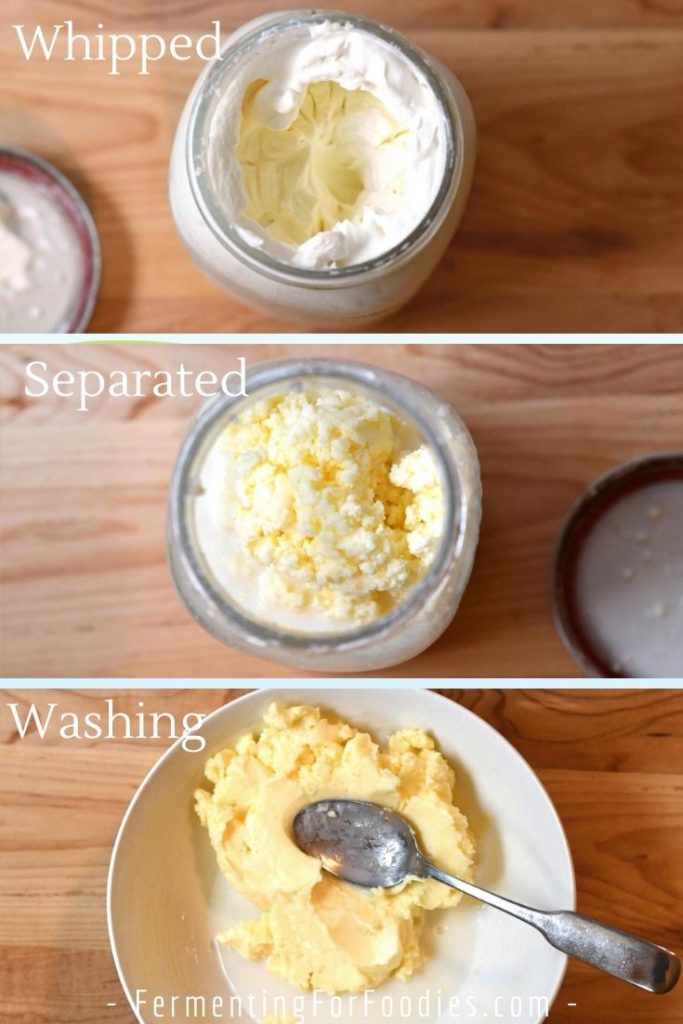
Additional Flavors
Homemade butter is perfect for making flavored butter. It’s easy to mix in flavors when you add the salt to the fresh butter. After mixing in the flavors, let the butter sit for 2 hours to infuse the flavors before serving.
Store flavored butter in the fridge for up to a week. You can also freeze flavored butter if you aren’t going to use it up right away.
I like storing the butter in rolls of wax paper (see picture below). It makes serving easy! Scrape the butter onto a piece of wax paper, and roughly form it into a tube. Then roll the wax paper around it and twist the ends of the paper to keep the roll closed. It’s that easy!
Here are five of my favorite flavors for butter:
- Herb: 1/4 cup of finely diced chives and parsley
- Basil: 1/4 cup of finely diced fresh basil
- Lemon: 1 tsp fresh lemon juice and 2 Tbsp lemon zest
- Garlic: 2 cloves of finely diced fresh garlic or 1 tsp garlic powder
- Sweet: 1/4 cup honey with 2 tsp cinnamon
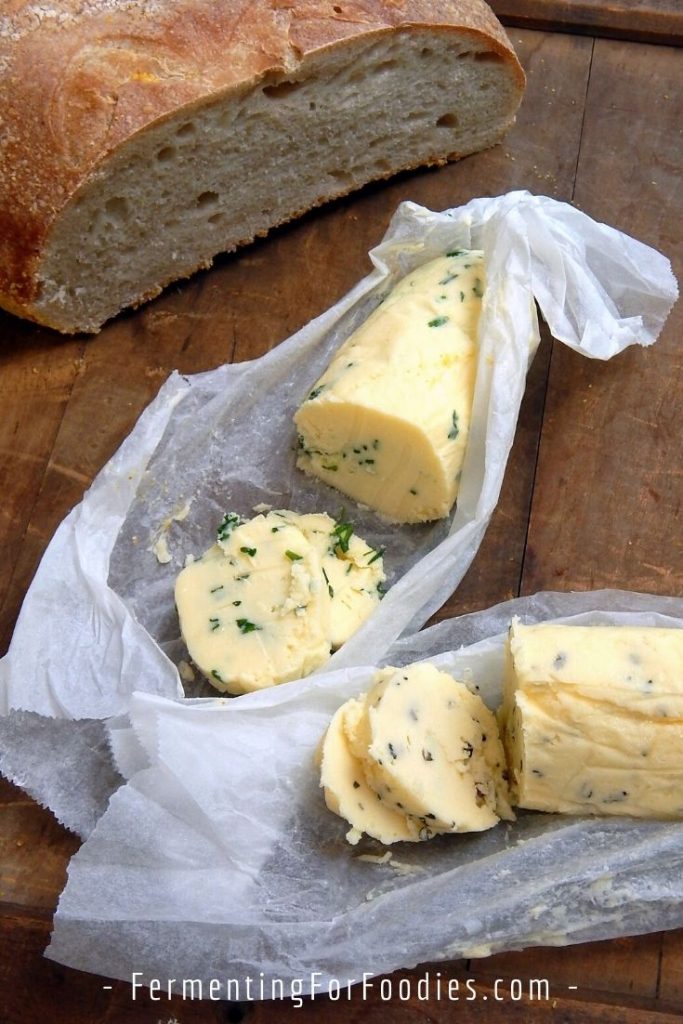
Simple Cultured Butter
It’s easy and fun to turn whipping cream into butter. Homemade cultured butter tastes divine. Serve it plain and salted or flavor it with herbs and garlic. See the section above for more flavor suggestions.
- Prep Time: 20 minutes
- Total Time: 20 minutes
- Yield: 1 cup 1x
- Category: Condiment
- Method: Fermented
- Cuisine: French
- Diet: Gluten Free
Ingredients
- 2 cups whipping cream (heavy cream)
- 2 Tbsp culture (see notes for options)
- Scant 1/4 tsp salt, to taste
Instructions
- Mix the whipping cream and the culture in a large jar. Leave it on the counter to culture for at least 12 hours.
- When you’re ready to make butter, start by whipping the cream. You can do this with a hand mixer, food processor, or stand mixer. You can also make butter by shaking the jar of cream. (See the section above for details on mason jar butter).
- The cream will whip and thicken so that it seems like nothing is happening, but keep whipping. After about 10 minutes the butterfat will separate from the buttermilk. (See photo above).
- Keep whipping until all the buttermilk has separated and the butter has formed into a ball.
- Scoop the butter out into a bowl. You want to extract as much buttermilk as possible to prevent the butter from going off. Start by pressing the butter into the bowl with the back of a spoon. Pour any buttermilk that comes out of the butter back into the jar. When you’ve squeezed out all the buttermilk, rinse the butter with cold water, then press the butter out with a spoon again.
- Rinse the butter with cold water a second time, and press out any remaining buttermilk.
- After all the liquid has drained away, sprinkle on some salt and any other flavors (see the section above for suggestions). Mix the salt into the butter with the spoon and put it into a container for serving and storage.
- Unsalted butter needs to be stored in the refrigerator. Otherwise, salted cultured butter can stay at room temperature for up to a week.
Notes
- Unpasteurized cream will naturally ferment without any additional culture. However, store-bought cream can be cultured with milk kefir grains, cultured sour cream, or cultured buttermilk. You can even use yogurt, but it’s easier to use a culture that doesn’t need to be kept warm.
- This recipe is designed for a 1-quart mason jar worth of butter. Two cups of cream make about 1 cup of butter and 1 cup of buttermilk.
- The buttermilk is AMAZING. My kids make butter just so they can drink the buttermilk! Alternatively, you can use the buttermilk for baking or pancakes. Fresh buttermilk is much thinner and sweeter than store-bought buttermilk, so it may not work in typical “buttermilk” recipes.



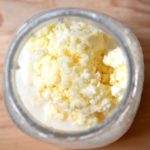

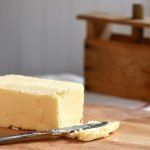
Could you use whey from yogurt for the culture?
Yes, but if it’s regular (heat-set yogurt) then it will need to culture at around 40 C.
When I am making yogurt with a thermophilic culture, I need to heat the milk to 180°F. If I’m using a commercial mesophilic culture with raw, extra-heavy cream, should I first scald cream, too? Or just bring the cream to room temperature before mixing in the culture?
Milk is scalded before making yogurt to denature the proteins so that it can thicken with the culturing. For cultured butter, you don’t want to scaled the cream, whether you’re using mesophilic or thermophilic culture. I usually just mix mesophilic culture into cold milk, then leave it out on the counter to warm up and culture. That’s because I culture milk nearly daily, so I just move my culture into a new jar every morning. 🙂
I have tried store bought whipping cream
But I cannot make butter because of pasteurization
I am unable to find unpasteurized heavy cream
Cream doesn’t need to be unpasteurized to make butter. If you can whip it, then it can turn into butter… you just need to keep whipping. It sort of hits this fully whipped, solid stage… then if you keep shaking, churning or whipping it slowly starts to separate into butter. Maybe try again?
I will be making this with raw whole milk. So does this mean, I simply need to make the butter (which I typically make with my kitchen aide mixer) and my left over buttermilk will be cultured? Or do I need to do something else to the buttermilk so it becomes cultured? Leave it out at room temperature for a set amount of time? Thank you for sharing your knowledge!
Yes! Your raw milk should contain culture, so it will naturally be cultured. If it’s not sour enough for your taste, then it should sour after a day or two. How long does it normally take for your milk to sour? (I do feel obligated to make some sort of disclaimer about the safety of raw milk… but if you drink it regularly then I’m sure you can judge for yourself.) 🙂 Enjoy!
Can you use whey from leftover yogurt making as the culture for this recipe? If the milk is unpasteurized can we skip step one and go straight to step two or does it still need to sit on the counter just without added culture?
Sorry, I see now similar questions have been asked. The whey is from probiotic yogurt. So it sounds like that should work as the culture. But I also get raw milk from a milk share so that by itself would also be cultured… so then I wouldn’t need the whey? And it sounds like I wouldn’t need to let the milk sit out I can just use it to make the butter right away and it will be cultured. Is that correct?
So, let me get this straight, I could make yogurt with my raw whole milk, use the whey to make cultured butter with the raw cream top, and then use the buttermilk (would I have to add milk as in your cultured buttermilk recipe?) to make probiotic cottage cheese?
Thanks so much for your guidance!
Phew! That’s quite a chain of ferments! Let’s see… cultured butter can be made with raw milk culture or yogurt cultured cream. It really doesn’t matter since it’s really the fat that makes the butter and the culture adds flavour! The buttermilk would be cultured as well… perfect for baking.
However, it won’t work for making cottage cheese. That’s because cottage cheese needs a specific culture. While all old-fashioned buttermilk would have been leftover from making butter, most (all?) grocery store buttermilk is cultured. It has its own unique culture that is the same one used to make cottage cheese. If your buttermilk has a yogurt culture, it will probably just turn milk into a yogurt-like ferment. Enjoy!
Okay thank you!! So the buttermilk obtained from my raw milk creamed butter doesn’t have the cultures needed to make buttermilk for cottage cheese? Even if I don’t use the whey from my yogurt to make either the butter or the buttermilk? Does all grocery store buttermilk have the cultures needed to make cream cheese or do I have to buy a specific brand? Thanks for your time!
The trick with raw milk is that it can contain a variety of different cultures. So it’s not easy to know exactly which cultures are in there. It might change based on what the cows are eating, the time of the year, etc. Store-bought buttermilk ought to contain a specific set of “buttermilk” cultures with can make cottage cheese. It was never an issue when I lived in Ireland, but finding a good buttermilk culture is harder in Canada and the USA. I recommend testing the culture first by making buttermilk with it. If it can culture buttermilk nicely, then it should set for cottage cheese!
We did this with your GF flatbread… awesomeness!!
Glad you enjoyed it!
I think I accidently made sour cream when I tried to culture it… so I didn’t get a chance to turn it into butter. Any guidance on why?? I used pasteurized from the store (NJ, raw milk illegal here, trying to figure out how to get it, no luck so far). I usually use plastic containers, this time I used glass, does that ever make a difference??? I’m happy (bc my sourcream attempts have all been watery and this was fantastic) but confused…
Sour cream and cultured cream are pretty much the something! So if you want butter… just take that sour cream and whip it. It will work! Alternatively, just shorten your culture time so that it doesn’t thicken. I’m guessing you’re using milk kefir? Culturing for less than 8 hours should avoid the thickening. Good luck!
I am assuming that cultured butter made from raw cream will keep in the fridge for months. Am I correct?
Maybe? The cultures in raw milk will help, but they aren’t 100% perfect. Just like cheese, butter can go moldy. However, salting the butter will help with preservation and prevent mold, thereby extending the refrigeration life. Cheers!
What happens if I shake the cream until it becomes more solid BEFORE it has time to culture? Can I leave it on the counter before squeezing out the liquid or do I call it a learning experience? 🙂
Butter can be made from uncultured cream. And… if you didn’t have time to culture it, but already added the culture, then it will continue to sour as it ages. Depending on how warm it is in your home, you may want to store the butter in the fridge. It will still slowly culture in the fridge but not be as liquidy. Cheers!
Do you know if I add olive oil to the end product to make a buttery spread (spreads straight from fridge) without it upsetting the probiotics?
What a great idea! I haven’t tried that. 🙂 I don’t think olive oil will influence the probiotics… especially since you won’t be adding it until after fermenting. Cheers, Emillie